Report on Blue Inc.: Finance, Resources, Employability, and Budget
VerifiedAdded on 2020/01/07
|16
|3554
|277
Report
AI Summary
This report provides an in-depth analysis of Blue Inc., a UK retailer, focusing on its financial operations, resources, and management practices. It begins by describing recruitment documentation, including job descriptions and person specifications for a finance controller role. The report then explores the importance of employability, personnel, and communication skills for a finance manager, highlighting personal attributes, interpersonal skills, and planning abilities. It also identifies and describes the main physical and technological resources utilized by Blue Inc., such as land, buildings, IT equipment, and energy, as well as how these resources can improve performance. Furthermore, the report examines various internal and external sources of finance available to Blue Inc., including equity investment, long-term debt, and short-term loans, as well as fixed and current assets. The report emphasizes the importance of managing and controlling budget costs to improve business performance, covering all essential elements for a comprehensive understanding of Blue Inc.'s financial and operational strategies.
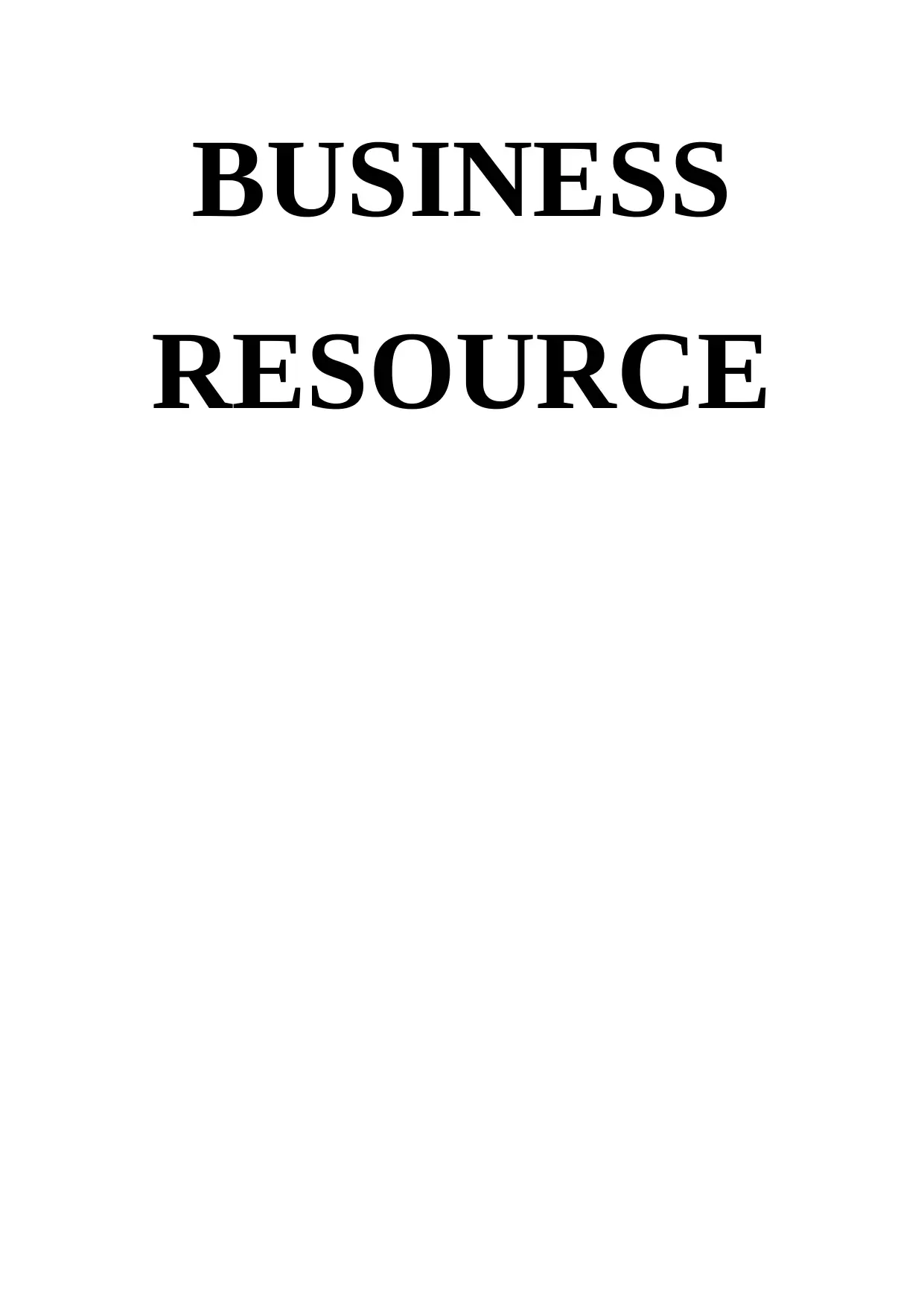
BUSINESS
RESOURCE
RESOURCE
Paraphrase This Document
Need a fresh take? Get an instant paraphrase of this document with our AI Paraphraser
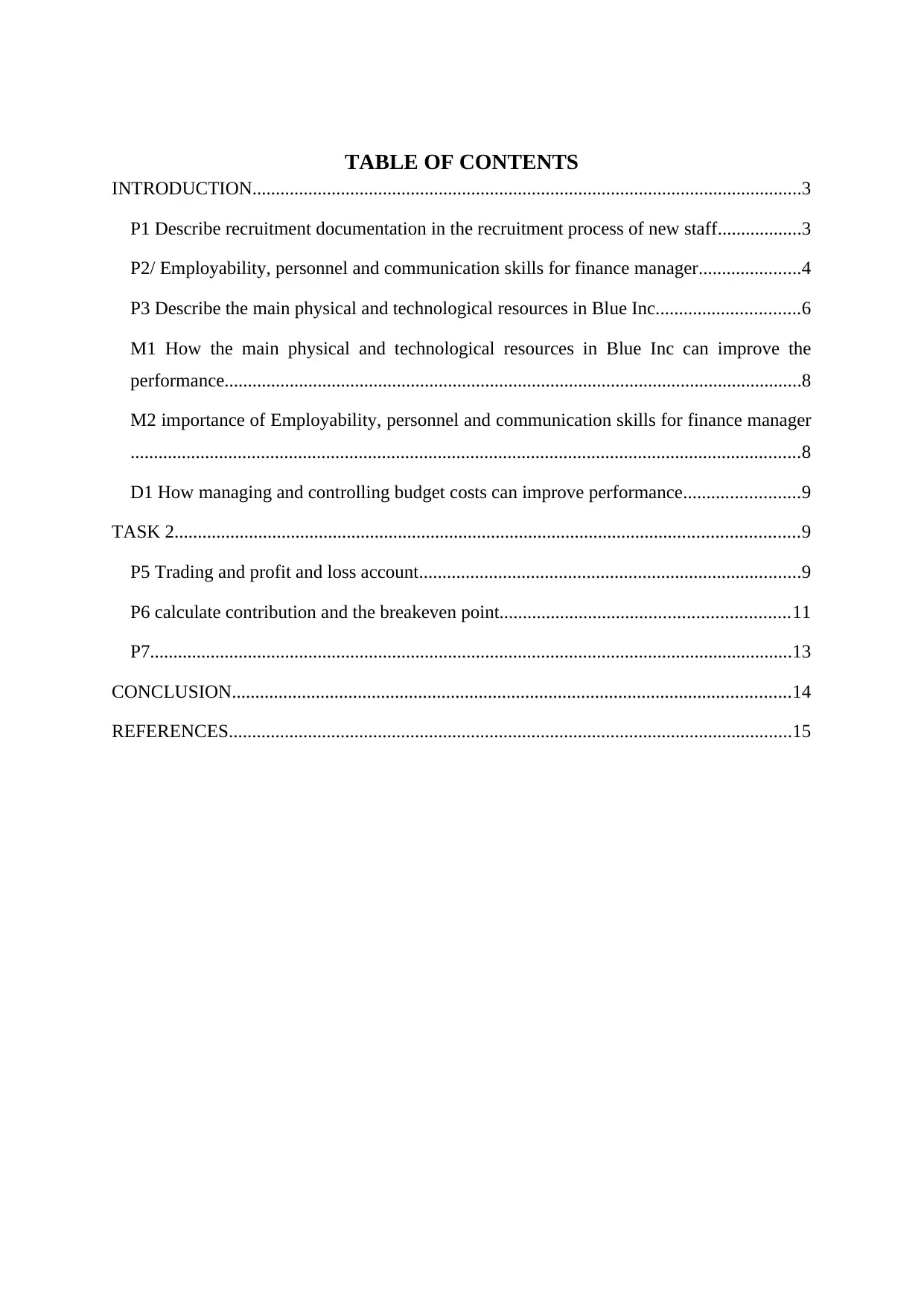
TABLE OF CONTENTS
INTRODUCTION......................................................................................................................3
P1 Describe recruitment documentation in the recruitment process of new staff..................3
P2/ Employability, personnel and communication skills for finance manager......................4
P3 Describe the main physical and technological resources in Blue Inc...............................6
M1 How the main physical and technological resources in Blue Inc can improve the
performance............................................................................................................................8
M2 importance of Employability, personnel and communication skills for finance manager
................................................................................................................................................8
D1 How managing and controlling budget costs can improve performance.........................9
TASK 2......................................................................................................................................9
P5 Trading and profit and loss account..................................................................................9
P6 calculate contribution and the breakeven point..............................................................11
P7..........................................................................................................................................13
CONCLUSION........................................................................................................................14
REFERENCES.........................................................................................................................15
INTRODUCTION......................................................................................................................3
P1 Describe recruitment documentation in the recruitment process of new staff..................3
P2/ Employability, personnel and communication skills for finance manager......................4
P3 Describe the main physical and technological resources in Blue Inc...............................6
M1 How the main physical and technological resources in Blue Inc can improve the
performance............................................................................................................................8
M2 importance of Employability, personnel and communication skills for finance manager
................................................................................................................................................8
D1 How managing and controlling budget costs can improve performance.........................9
TASK 2......................................................................................................................................9
P5 Trading and profit and loss account..................................................................................9
P6 calculate contribution and the breakeven point..............................................................11
P7..........................................................................................................................................13
CONCLUSION........................................................................................................................14
REFERENCES.........................................................................................................................15
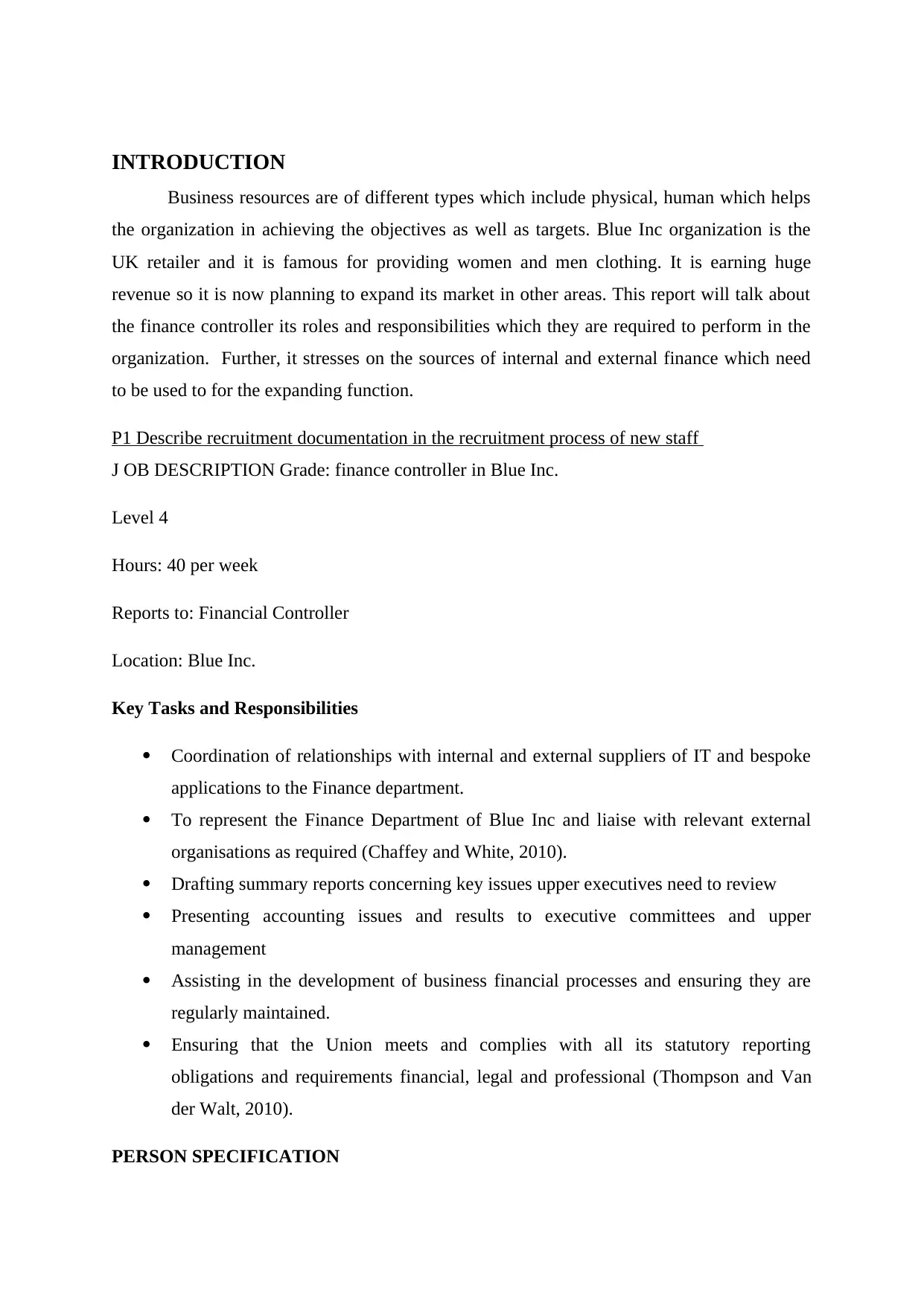
INTRODUCTION
Business resources are of different types which include physical, human which helps
the organization in achieving the objectives as well as targets. Blue Inc organization is the
UK retailer and it is famous for providing women and men clothing. It is earning huge
revenue so it is now planning to expand its market in other areas. This report will talk about
the finance controller its roles and responsibilities which they are required to perform in the
organization. Further, it stresses on the sources of internal and external finance which need
to be used to for the expanding function.
P1 Describe recruitment documentation in the recruitment process of new staff
J OB DESCRIPTION Grade: finance controller in Blue Inc.
Level 4
Hours: 40 per week
Reports to: Financial Controller
Location: Blue Inc.
Key Tasks and Responsibilities
Coordination of relationships with internal and external suppliers of IT and bespoke
applications to the Finance department.
To represent the Finance Department of Blue Inc and liaise with relevant external
organisations as required (Chaffey and White, 2010).
Drafting summary reports concerning key issues upper executives need to review
Presenting accounting issues and results to executive committees and upper
management
Assisting in the development of business financial processes and ensuring they are
regularly maintained.
Ensuring that the Union meets and complies with all its statutory reporting
obligations and requirements financial, legal and professional (Thompson and Van
der Walt, 2010).
PERSON SPECIFICATION
Business resources are of different types which include physical, human which helps
the organization in achieving the objectives as well as targets. Blue Inc organization is the
UK retailer and it is famous for providing women and men clothing. It is earning huge
revenue so it is now planning to expand its market in other areas. This report will talk about
the finance controller its roles and responsibilities which they are required to perform in the
organization. Further, it stresses on the sources of internal and external finance which need
to be used to for the expanding function.
P1 Describe recruitment documentation in the recruitment process of new staff
J OB DESCRIPTION Grade: finance controller in Blue Inc.
Level 4
Hours: 40 per week
Reports to: Financial Controller
Location: Blue Inc.
Key Tasks and Responsibilities
Coordination of relationships with internal and external suppliers of IT and bespoke
applications to the Finance department.
To represent the Finance Department of Blue Inc and liaise with relevant external
organisations as required (Chaffey and White, 2010).
Drafting summary reports concerning key issues upper executives need to review
Presenting accounting issues and results to executive committees and upper
management
Assisting in the development of business financial processes and ensuring they are
regularly maintained.
Ensuring that the Union meets and complies with all its statutory reporting
obligations and requirements financial, legal and professional (Thompson and Van
der Walt, 2010).
PERSON SPECIFICATION
⊘ This is a preview!⊘
Do you want full access?
Subscribe today to unlock all pages.

Trusted by 1+ million students worldwide
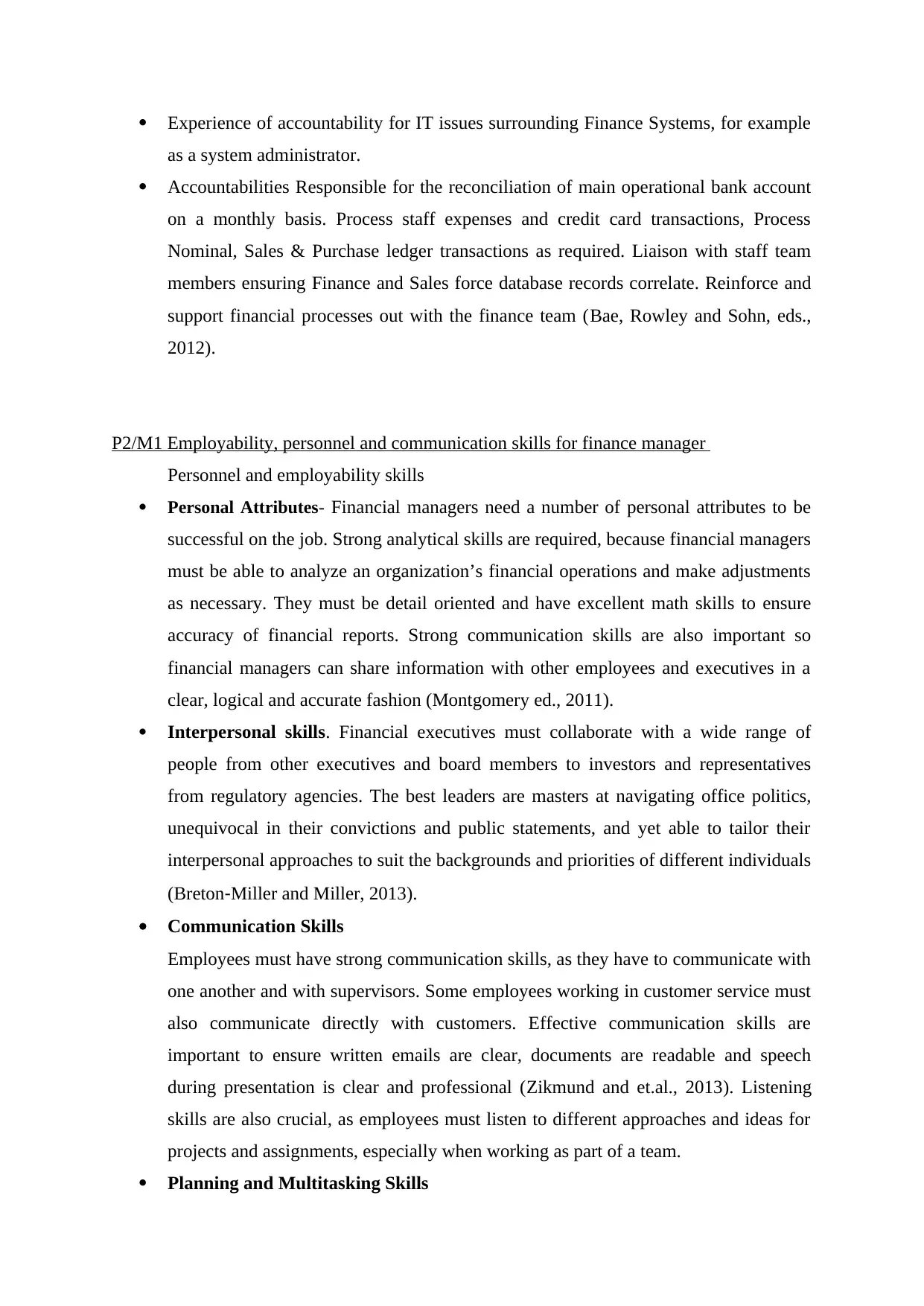
Experience of accountability for IT issues surrounding Finance Systems, for example
as a system administrator.
Accountabilities Responsible for the reconciliation of main operational bank account
on a monthly basis. Process staff expenses and credit card transactions, Process
Nominal, Sales & Purchase ledger transactions as required. Liaison with staff team
members ensuring Finance and Sales force database records correlate. Reinforce and
support financial processes out with the finance team (Bae, Rowley and Sohn, eds.,
2012).
P2/M1 Employability, personnel and communication skills for finance manager
Personnel and employability skills
Personal Attributes- Financial managers need a number of personal attributes to be
successful on the job. Strong analytical skills are required, because financial managers
must be able to analyze an organization’s financial operations and make adjustments
as necessary. They must be detail oriented and have excellent math skills to ensure
accuracy of financial reports. Strong communication skills are also important so
financial managers can share information with other employees and executives in a
clear, logical and accurate fashion (Montgomery ed., 2011).
Interpersonal skills. Financial executives must collaborate with a wide range of
people from other executives and board members to investors and representatives
from regulatory agencies. The best leaders are masters at navigating office politics,
unequivocal in their convictions and public statements, and yet able to tailor their
interpersonal approaches to suit the backgrounds and priorities of different individuals
(Breton‐Miller and Miller, 2013).
Communication Skills
Employees must have strong communication skills, as they have to communicate with
one another and with supervisors. Some employees working in customer service must
also communicate directly with customers. Effective communication skills are
important to ensure written emails are clear, documents are readable and speech
during presentation is clear and professional (Zikmund and et.al., 2013). Listening
skills are also crucial, as employees must listen to different approaches and ideas for
projects and assignments, especially when working as part of a team.
Planning and Multitasking Skills
as a system administrator.
Accountabilities Responsible for the reconciliation of main operational bank account
on a monthly basis. Process staff expenses and credit card transactions, Process
Nominal, Sales & Purchase ledger transactions as required. Liaison with staff team
members ensuring Finance and Sales force database records correlate. Reinforce and
support financial processes out with the finance team (Bae, Rowley and Sohn, eds.,
2012).
P2/M1 Employability, personnel and communication skills for finance manager
Personnel and employability skills
Personal Attributes- Financial managers need a number of personal attributes to be
successful on the job. Strong analytical skills are required, because financial managers
must be able to analyze an organization’s financial operations and make adjustments
as necessary. They must be detail oriented and have excellent math skills to ensure
accuracy of financial reports. Strong communication skills are also important so
financial managers can share information with other employees and executives in a
clear, logical and accurate fashion (Montgomery ed., 2011).
Interpersonal skills. Financial executives must collaborate with a wide range of
people from other executives and board members to investors and representatives
from regulatory agencies. The best leaders are masters at navigating office politics,
unequivocal in their convictions and public statements, and yet able to tailor their
interpersonal approaches to suit the backgrounds and priorities of different individuals
(Breton‐Miller and Miller, 2013).
Communication Skills
Employees must have strong communication skills, as they have to communicate with
one another and with supervisors. Some employees working in customer service must
also communicate directly with customers. Effective communication skills are
important to ensure written emails are clear, documents are readable and speech
during presentation is clear and professional (Zikmund and et.al., 2013). Listening
skills are also crucial, as employees must listen to different approaches and ideas for
projects and assignments, especially when working as part of a team.
Planning and Multitasking Skills
Paraphrase This Document
Need a fresh take? Get an instant paraphrase of this document with our AI Paraphraser
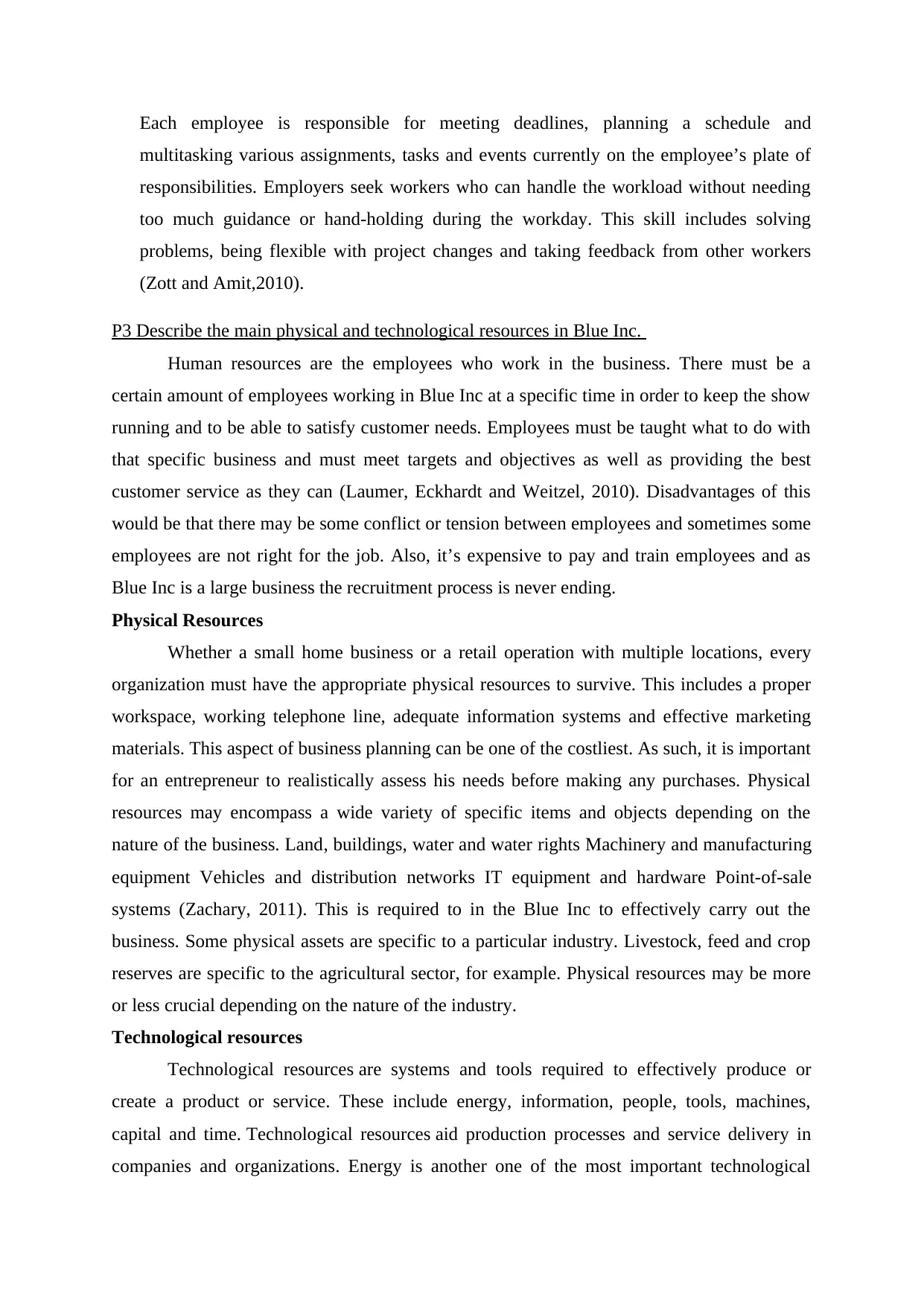
Each employee is responsible for meeting deadlines, planning a schedule and
multitasking various assignments, tasks and events currently on the employee’s plate of
responsibilities. Employers seek workers who can handle the workload without needing
too much guidance or hand-holding during the workday. This skill includes solving
problems, being flexible with project changes and taking feedback from other workers
(Zott and Amit,2010).
P3 Describe the main physical and technological resources in Blue Inc.
Human resources are the employees who work in the business. There must be a
certain amount of employees working in Blue Inc at a specific time in order to keep the show
running and to be able to satisfy customer needs. Employees must be taught what to do with
that specific business and must meet targets and objectives as well as providing the best
customer service as they can (Laumer, Eckhardt and Weitzel, 2010). Disadvantages of this
would be that there may be some conflict or tension between employees and sometimes some
employees are not right for the job. Also, it’s expensive to pay and train employees and as
Blue Inc is a large business the recruitment process is never ending.
Physical Resources
Whether a small home business or a retail operation with multiple locations, every
organization must have the appropriate physical resources to survive. This includes a proper
workspace, working telephone line, adequate information systems and effective marketing
materials. This aspect of business planning can be one of the costliest. As such, it is important
for an entrepreneur to realistically assess his needs before making any purchases. Physical
resources may encompass a wide variety of specific items and objects depending on the
nature of the business. Land, buildings, water and water rights Machinery and manufacturing
equipment Vehicles and distribution networks IT equipment and hardware Point-of-sale
systems (Zachary, 2011). This is required to in the Blue Inc to effectively carry out the
business. Some physical assets are specific to a particular industry. Livestock, feed and crop
reserves are specific to the agricultural sector, for example. Physical resources may be more
or less crucial depending on the nature of the industry.
Technological resources
Technological resources are systems and tools required to effectively produce or
create a product or service. These include energy, information, people, tools, machines,
capital and time. Technological resources aid production processes and service delivery in
companies and organizations. Energy is another one of the most important technological
multitasking various assignments, tasks and events currently on the employee’s plate of
responsibilities. Employers seek workers who can handle the workload without needing
too much guidance or hand-holding during the workday. This skill includes solving
problems, being flexible with project changes and taking feedback from other workers
(Zott and Amit,2010).
P3 Describe the main physical and technological resources in Blue Inc.
Human resources are the employees who work in the business. There must be a
certain amount of employees working in Blue Inc at a specific time in order to keep the show
running and to be able to satisfy customer needs. Employees must be taught what to do with
that specific business and must meet targets and objectives as well as providing the best
customer service as they can (Laumer, Eckhardt and Weitzel, 2010). Disadvantages of this
would be that there may be some conflict or tension between employees and sometimes some
employees are not right for the job. Also, it’s expensive to pay and train employees and as
Blue Inc is a large business the recruitment process is never ending.
Physical Resources
Whether a small home business or a retail operation with multiple locations, every
organization must have the appropriate physical resources to survive. This includes a proper
workspace, working telephone line, adequate information systems and effective marketing
materials. This aspect of business planning can be one of the costliest. As such, it is important
for an entrepreneur to realistically assess his needs before making any purchases. Physical
resources may encompass a wide variety of specific items and objects depending on the
nature of the business. Land, buildings, water and water rights Machinery and manufacturing
equipment Vehicles and distribution networks IT equipment and hardware Point-of-sale
systems (Zachary, 2011). This is required to in the Blue Inc to effectively carry out the
business. Some physical assets are specific to a particular industry. Livestock, feed and crop
reserves are specific to the agricultural sector, for example. Physical resources may be more
or less crucial depending on the nature of the industry.
Technological resources
Technological resources are systems and tools required to effectively produce or
create a product or service. These include energy, information, people, tools, machines,
capital and time. Technological resources aid production processes and service delivery in
companies and organizations. Energy is another one of the most important technological

resources. Most forms of technology rely on energy for power. Machines driven by energy
are an invaluable resource in industries that rely on continuous and mass production. it is an
additional resource important to technology. It determines quantity of production and the
volume of labour required (Korunka and et.al., 2010). Proper coordination of technological
resources helps an organization or company to create products and deliver services efficiently
and effectively. Augmented reality refers to the process of using digital information to
improve navigation of the real world. With technologies such as Google Glass and
Smartphone applications, augmented reality allows users to access a wealth of
information on the fly. Map tools help facilitate transportation, whether it is on a bike or
the subway, while other apps help users locate nearby stores or services.
Advancements in telecommunication technology have improved access to medical
resources and information, especially for doctors in rural or disadvantaged areas.
Physicians can communicate with experts from all over the world, improving patients'
diagnoses and treatment without the need to travel (Hart and Dowell, 2011).
P4 Range of internal and external source of finance for Blue Inc.
Equity Investment
Equity investment means that you accept money from a private investor or group in
exchange for partial ownership of the business. This funding source is commonly used by
small-business owners who want to quickly grow the business. With equity investment, you
don't take on debt and you don't have to repay the investment (Zott, Amit and Massa, 2011).
However, you do give up some ownership and control of the business. Major investors often
want a seat on the company board and a say in how you operate the business.
Long-Term Debt
One type of external debt financing is long-term debt. Long-term loans typically
include any debts that you expect to take more than a year to repay. Commonly, though, your
long-term loans are used to purchase buildings, equipment and other major assets. An
advantage of long-term financing is that you can repay the loan over an extended period,
which minimizes your monthly payment obligation. Plus, interest on property purchases is
often tax-deductible (Carroll and Shabana, 2010). One drawback to this type of loan is that
it's usually secured by property, meaning if you can't take it back, the lender can seize your
building, equipment or inventory.
Short-Term Loans and Lines of Credit
are an invaluable resource in industries that rely on continuous and mass production. it is an
additional resource important to technology. It determines quantity of production and the
volume of labour required (Korunka and et.al., 2010). Proper coordination of technological
resources helps an organization or company to create products and deliver services efficiently
and effectively. Augmented reality refers to the process of using digital information to
improve navigation of the real world. With technologies such as Google Glass and
Smartphone applications, augmented reality allows users to access a wealth of
information on the fly. Map tools help facilitate transportation, whether it is on a bike or
the subway, while other apps help users locate nearby stores or services.
Advancements in telecommunication technology have improved access to medical
resources and information, especially for doctors in rural or disadvantaged areas.
Physicians can communicate with experts from all over the world, improving patients'
diagnoses and treatment without the need to travel (Hart and Dowell, 2011).
P4 Range of internal and external source of finance for Blue Inc.
Equity Investment
Equity investment means that you accept money from a private investor or group in
exchange for partial ownership of the business. This funding source is commonly used by
small-business owners who want to quickly grow the business. With equity investment, you
don't take on debt and you don't have to repay the investment (Zott, Amit and Massa, 2011).
However, you do give up some ownership and control of the business. Major investors often
want a seat on the company board and a say in how you operate the business.
Long-Term Debt
One type of external debt financing is long-term debt. Long-term loans typically
include any debts that you expect to take more than a year to repay. Commonly, though, your
long-term loans are used to purchase buildings, equipment and other major assets. An
advantage of long-term financing is that you can repay the loan over an extended period,
which minimizes your monthly payment obligation. Plus, interest on property purchases is
often tax-deductible (Carroll and Shabana, 2010). One drawback to this type of loan is that
it's usually secured by property, meaning if you can't take it back, the lender can seize your
building, equipment or inventory.
Short-Term Loans and Lines of Credit
⊘ This is a preview!⊘
Do you want full access?
Subscribe today to unlock all pages.

Trusted by 1+ million students worldwide
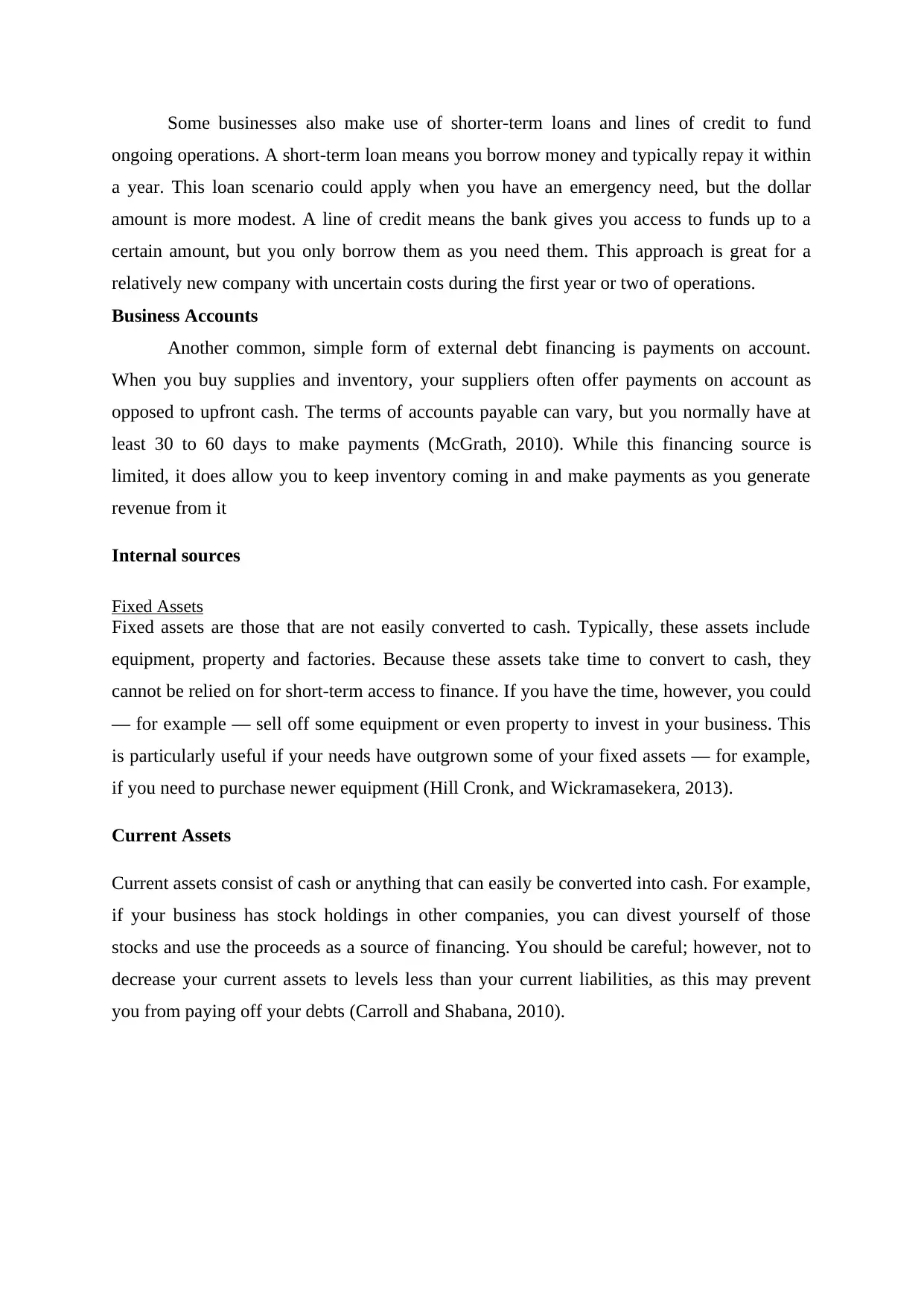
Some businesses also make use of shorter-term loans and lines of credit to fund
ongoing operations. A short-term loan means you borrow money and typically repay it within
a year. This loan scenario could apply when you have an emergency need, but the dollar
amount is more modest. A line of credit means the bank gives you access to funds up to a
certain amount, but you only borrow them as you need them. This approach is great for a
relatively new company with uncertain costs during the first year or two of operations.
Business Accounts
Another common, simple form of external debt financing is payments on account.
When you buy supplies and inventory, your suppliers often offer payments on account as
opposed to upfront cash. The terms of accounts payable can vary, but you normally have at
least 30 to 60 days to make payments (McGrath, 2010). While this financing source is
limited, it does allow you to keep inventory coming in and make payments as you generate
revenue from it
Internal sources
Fixed Assets
Fixed assets are those that are not easily converted to cash. Typically, these assets include
equipment, property and factories. Because these assets take time to convert to cash, they
cannot be relied on for short-term access to finance. If you have the time, however, you could
— for example — sell off some equipment or even property to invest in your business. This
is particularly useful if your needs have outgrown some of your fixed assets — for example,
if you need to purchase newer equipment (Hill Cronk, and Wickramasekera, 2013).
Current Assets
Current assets consist of cash or anything that can easily be converted into cash. For example,
if your business has stock holdings in other companies, you can divest yourself of those
stocks and use the proceeds as a source of financing. You should be careful; however, not to
decrease your current assets to levels less than your current liabilities, as this may prevent
you from paying off your debts (Carroll and Shabana, 2010).
ongoing operations. A short-term loan means you borrow money and typically repay it within
a year. This loan scenario could apply when you have an emergency need, but the dollar
amount is more modest. A line of credit means the bank gives you access to funds up to a
certain amount, but you only borrow them as you need them. This approach is great for a
relatively new company with uncertain costs during the first year or two of operations.
Business Accounts
Another common, simple form of external debt financing is payments on account.
When you buy supplies and inventory, your suppliers often offer payments on account as
opposed to upfront cash. The terms of accounts payable can vary, but you normally have at
least 30 to 60 days to make payments (McGrath, 2010). While this financing source is
limited, it does allow you to keep inventory coming in and make payments as you generate
revenue from it
Internal sources
Fixed Assets
Fixed assets are those that are not easily converted to cash. Typically, these assets include
equipment, property and factories. Because these assets take time to convert to cash, they
cannot be relied on for short-term access to finance. If you have the time, however, you could
— for example — sell off some equipment or even property to invest in your business. This
is particularly useful if your needs have outgrown some of your fixed assets — for example,
if you need to purchase newer equipment (Hill Cronk, and Wickramasekera, 2013).
Current Assets
Current assets consist of cash or anything that can easily be converted into cash. For example,
if your business has stock holdings in other companies, you can divest yourself of those
stocks and use the proceeds as a source of financing. You should be careful; however, not to
decrease your current assets to levels less than your current liabilities, as this may prevent
you from paying off your debts (Carroll and Shabana, 2010).
Paraphrase This Document
Need a fresh take? Get an instant paraphrase of this document with our AI Paraphraser

M1 How the main physical and technological resources in Blue Inc can improve the
performance
These are the factors which are helpful in increasing the profitability of the
organization. With the help of human resource, the Blue Inc organization will manage their
work as the task which is carried out in the organization is because of the employees. On the
other hand, technological will help the employees to make the work easier of the workforce.
This is because the time taken will be less and they have to do less work in completing the
task.
M2 importance of Employability, personnel and communication skills for finance manager
Communication, personnel and employability skills are required in the organization to
make the work effective. Finance manger is required to effectively communicate their
requirement of finance to the management. Further, they conduct meeting for communicating
the budget as in this case, they need to have the effective communication skill. Personnel skill
assists the manager in developing relationship in the organization. This will help in
improving the bonding among the workers.
D1 How managing and controlling budget costs can improve performance
Managing resources and controlling budget costs can improve the business
performance in many ways. All businesses need to control their budgets but especially large
businesses. Budgets must be controlled in order for a business to make a profit rather than a
loss within their business. They must use their past history in order to predict how well they
will be able to perform in the next month as they can be inspirational for example aim to
increase sales by 2% each month. You must make sure you look ahead for example if you
know some of your part time staff will be leaving you need to make sure you leave a slice of
money in your budget to cover costs for recruitment for example there may need to be more
advertising in order to find the right person. Money would be being wasted and could be
spent on more productive things such as advertising in order to promote the business.
TASK 2
P5 Trading and profit and loss account
Ratio analysis is used to evaluate various aspects of a company's operating and
financial performance such as its efficiency, liquidity, profitability and solvency. The trend of
these ratios over time is studied to check whether they are improving or deteriorating. Ratio
performance
These are the factors which are helpful in increasing the profitability of the
organization. With the help of human resource, the Blue Inc organization will manage their
work as the task which is carried out in the organization is because of the employees. On the
other hand, technological will help the employees to make the work easier of the workforce.
This is because the time taken will be less and they have to do less work in completing the
task.
M2 importance of Employability, personnel and communication skills for finance manager
Communication, personnel and employability skills are required in the organization to
make the work effective. Finance manger is required to effectively communicate their
requirement of finance to the management. Further, they conduct meeting for communicating
the budget as in this case, they need to have the effective communication skill. Personnel skill
assists the manager in developing relationship in the organization. This will help in
improving the bonding among the workers.
D1 How managing and controlling budget costs can improve performance
Managing resources and controlling budget costs can improve the business
performance in many ways. All businesses need to control their budgets but especially large
businesses. Budgets must be controlled in order for a business to make a profit rather than a
loss within their business. They must use their past history in order to predict how well they
will be able to perform in the next month as they can be inspirational for example aim to
increase sales by 2% each month. You must make sure you look ahead for example if you
know some of your part time staff will be leaving you need to make sure you leave a slice of
money in your budget to cover costs for recruitment for example there may need to be more
advertising in order to find the right person. Money would be being wasted and could be
spent on more productive things such as advertising in order to promote the business.
TASK 2
P5 Trading and profit and loss account
Ratio analysis is used to evaluate various aspects of a company's operating and
financial performance such as its efficiency, liquidity, profitability and solvency. The trend of
these ratios over time is studied to check whether they are improving or deteriorating. Ratio
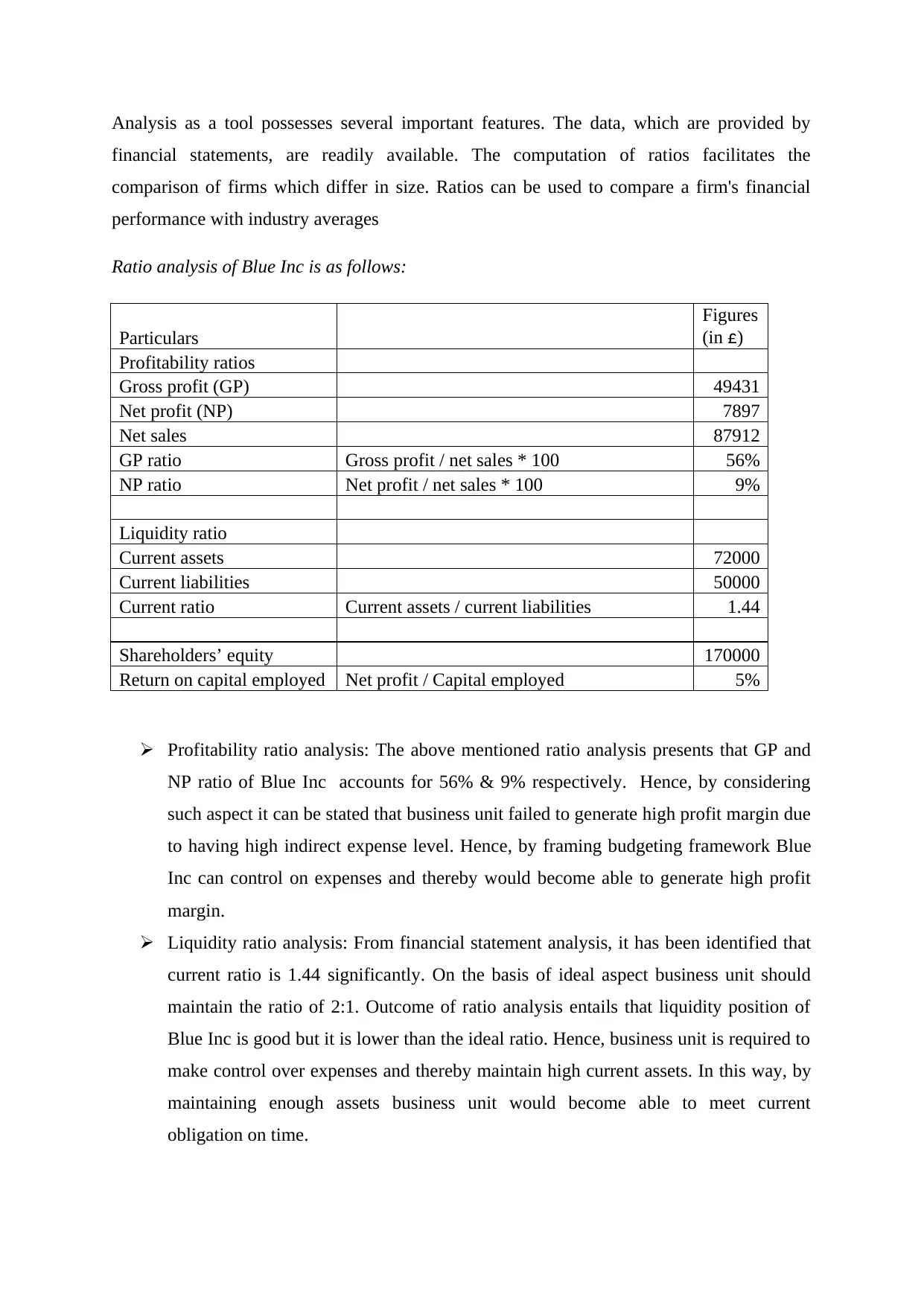
Analysis as a tool possesses several important features. The data, which are provided by
financial statements, are readily available. The computation of ratios facilitates the
comparison of firms which differ in size. Ratios can be used to compare a firm's financial
performance with industry averages
Ratio analysis of Blue Inc is as follows:
Particulars
Figures
(in £)
Profitability ratios
Gross profit (GP) 49431
Net profit (NP) 7897
Net sales 87912
GP ratio Gross profit / net sales * 100 56%
NP ratio Net profit / net sales * 100 9%
Liquidity ratio
Current assets 72000
Current liabilities 50000
Current ratio Current assets / current liabilities 1.44
Shareholders’ equity 170000
Return on capital employed Net profit / Capital employed 5%
Profitability ratio analysis: The above mentioned ratio analysis presents that GP and
NP ratio of Blue Inc accounts for 56% & 9% respectively. Hence, by considering
such aspect it can be stated that business unit failed to generate high profit margin due
to having high indirect expense level. Hence, by framing budgeting framework Blue
Inc can control on expenses and thereby would become able to generate high profit
margin.
Liquidity ratio analysis: From financial statement analysis, it has been identified that
current ratio is 1.44 significantly. On the basis of ideal aspect business unit should
maintain the ratio of 2:1. Outcome of ratio analysis entails that liquidity position of
Blue Inc is good but it is lower than the ideal ratio. Hence, business unit is required to
make control over expenses and thereby maintain high current assets. In this way, by
maintaining enough assets business unit would become able to meet current
obligation on time.
financial statements, are readily available. The computation of ratios facilitates the
comparison of firms which differ in size. Ratios can be used to compare a firm's financial
performance with industry averages
Ratio analysis of Blue Inc is as follows:
Particulars
Figures
(in £)
Profitability ratios
Gross profit (GP) 49431
Net profit (NP) 7897
Net sales 87912
GP ratio Gross profit / net sales * 100 56%
NP ratio Net profit / net sales * 100 9%
Liquidity ratio
Current assets 72000
Current liabilities 50000
Current ratio Current assets / current liabilities 1.44
Shareholders’ equity 170000
Return on capital employed Net profit / Capital employed 5%
Profitability ratio analysis: The above mentioned ratio analysis presents that GP and
NP ratio of Blue Inc accounts for 56% & 9% respectively. Hence, by considering
such aspect it can be stated that business unit failed to generate high profit margin due
to having high indirect expense level. Hence, by framing budgeting framework Blue
Inc can control on expenses and thereby would become able to generate high profit
margin.
Liquidity ratio analysis: From financial statement analysis, it has been identified that
current ratio is 1.44 significantly. On the basis of ideal aspect business unit should
maintain the ratio of 2:1. Outcome of ratio analysis entails that liquidity position of
Blue Inc is good but it is lower than the ideal ratio. Hence, business unit is required to
make control over expenses and thereby maintain high current assets. In this way, by
maintaining enough assets business unit would become able to meet current
obligation on time.
⊘ This is a preview!⊘
Do you want full access?
Subscribe today to unlock all pages.

Trusted by 1+ million students worldwide
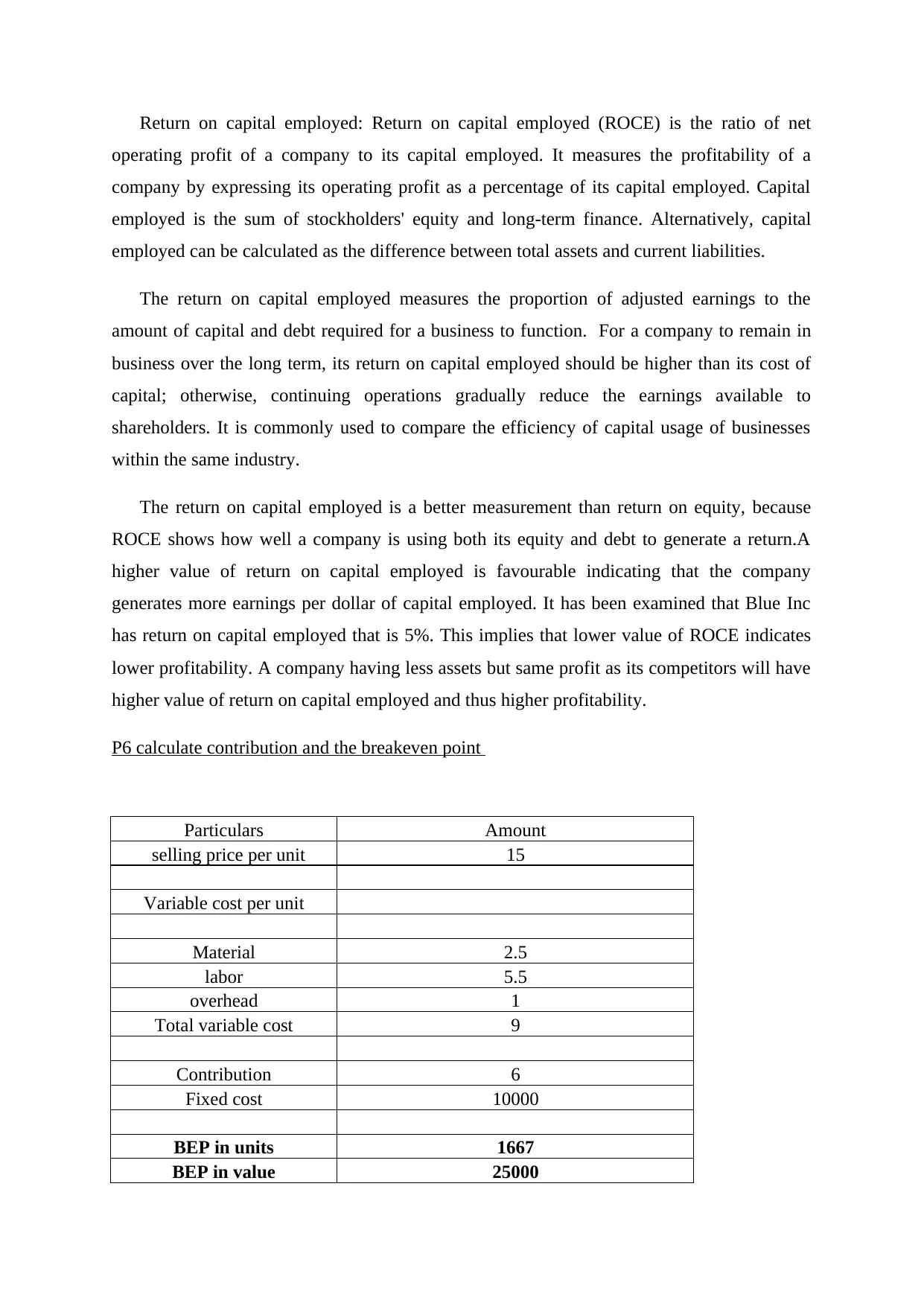
Return on capital employed: Return on capital employed (ROCE) is the ratio of net
operating profit of a company to its capital employed. It measures the profitability of a
company by expressing its operating profit as a percentage of its capital employed. Capital
employed is the sum of stockholders' equity and long-term finance. Alternatively, capital
employed can be calculated as the difference between total assets and current liabilities.
The return on capital employed measures the proportion of adjusted earnings to the
amount of capital and debt required for a business to function. For a company to remain in
business over the long term, its return on capital employed should be higher than its cost of
capital; otherwise, continuing operations gradually reduce the earnings available to
shareholders. It is commonly used to compare the efficiency of capital usage of businesses
within the same industry.
The return on capital employed is a better measurement than return on equity, because
ROCE shows how well a company is using both its equity and debt to generate a return.A
higher value of return on capital employed is favourable indicating that the company
generates more earnings per dollar of capital employed. It has been examined that Blue Inc
has return on capital employed that is 5%. This implies that lower value of ROCE indicates
lower profitability. A company having less assets but same profit as its competitors will have
higher value of return on capital employed and thus higher profitability.
P6 calculate contribution and the breakeven point
Particulars Amount
selling price per unit 15
Variable cost per unit
Material 2.5
labor 5.5
overhead 1
Total variable cost 9
Contribution 6
Fixed cost 10000
BEP in units 1667
BEP in value 25000
operating profit of a company to its capital employed. It measures the profitability of a
company by expressing its operating profit as a percentage of its capital employed. Capital
employed is the sum of stockholders' equity and long-term finance. Alternatively, capital
employed can be calculated as the difference between total assets and current liabilities.
The return on capital employed measures the proportion of adjusted earnings to the
amount of capital and debt required for a business to function. For a company to remain in
business over the long term, its return on capital employed should be higher than its cost of
capital; otherwise, continuing operations gradually reduce the earnings available to
shareholders. It is commonly used to compare the efficiency of capital usage of businesses
within the same industry.
The return on capital employed is a better measurement than return on equity, because
ROCE shows how well a company is using both its equity and debt to generate a return.A
higher value of return on capital employed is favourable indicating that the company
generates more earnings per dollar of capital employed. It has been examined that Blue Inc
has return on capital employed that is 5%. This implies that lower value of ROCE indicates
lower profitability. A company having less assets but same profit as its competitors will have
higher value of return on capital employed and thus higher profitability.
P6 calculate contribution and the breakeven point
Particulars Amount
selling price per unit 15
Variable cost per unit
Material 2.5
labor 5.5
overhead 1
Total variable cost 9
Contribution 6
Fixed cost 10000
BEP in units 1667
BEP in value 25000
Paraphrase This Document
Need a fresh take? Get an instant paraphrase of this document with our AI Paraphraser
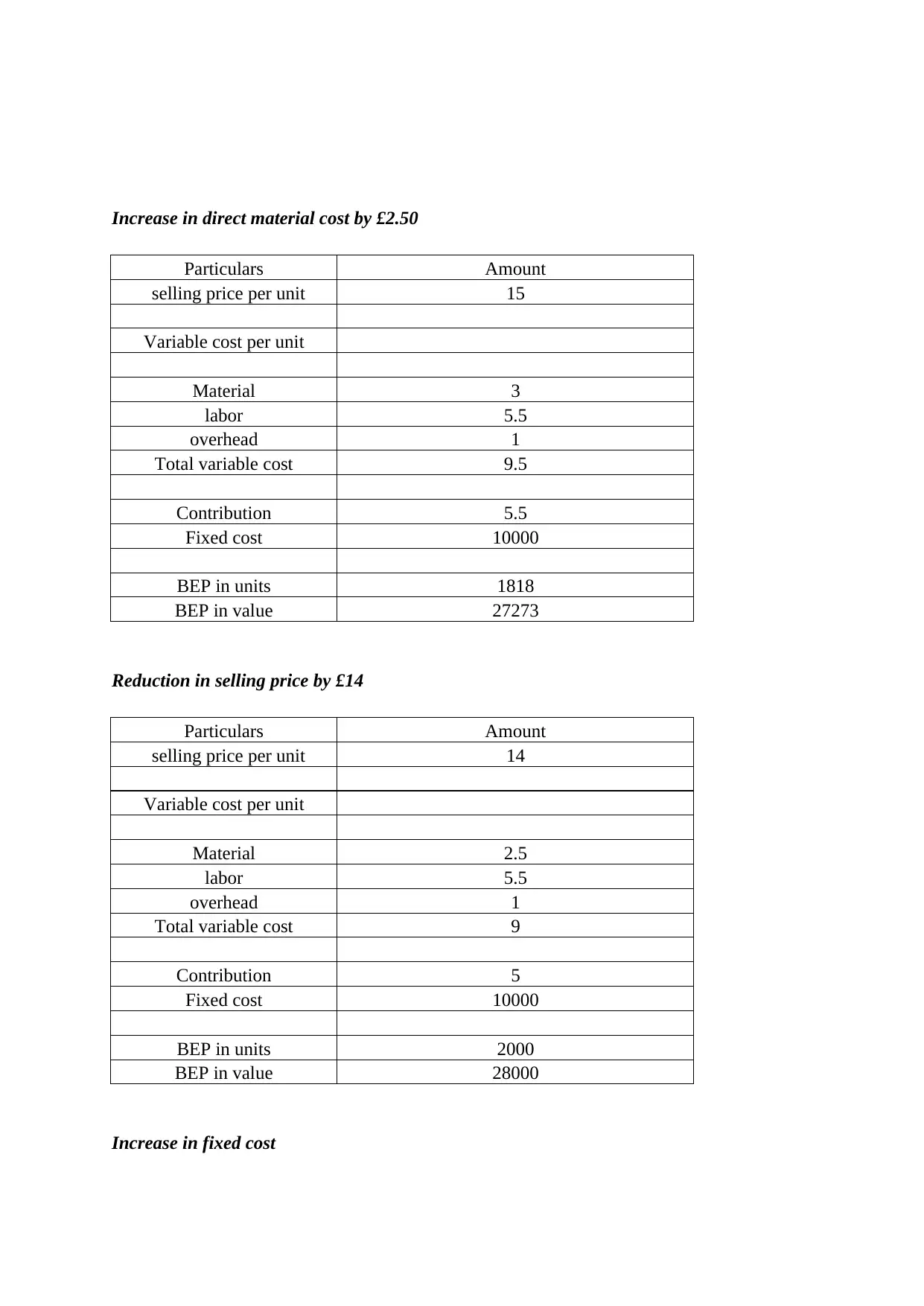
Increase in direct material cost by £2.50
Particulars Amount
selling price per unit 15
Variable cost per unit
Material 3
labor 5.5
overhead 1
Total variable cost 9.5
Contribution 5.5
Fixed cost 10000
BEP in units 1818
BEP in value 27273
Reduction in selling price by £14
Particulars Amount
selling price per unit 14
Variable cost per unit
Material 2.5
labor 5.5
overhead 1
Total variable cost 9
Contribution 5
Fixed cost 10000
BEP in units 2000
BEP in value 28000
Increase in fixed cost
Particulars Amount
selling price per unit 15
Variable cost per unit
Material 3
labor 5.5
overhead 1
Total variable cost 9.5
Contribution 5.5
Fixed cost 10000
BEP in units 1818
BEP in value 27273
Reduction in selling price by £14
Particulars Amount
selling price per unit 14
Variable cost per unit
Material 2.5
labor 5.5
overhead 1
Total variable cost 9
Contribution 5
Fixed cost 10000
BEP in units 2000
BEP in value 28000
Increase in fixed cost

Particulars Amount
selling price per unit 15
Variable cost per unit
Material 2.5
labor 5.5
overhead 1
Total variable cost 9
Contribution 6
Fixed cost 11000
BEP in units 1833
BEP in value 27500
Decrease invariable overhead such as £0.75
Particulars Amount
selling price per unit 15
Variable cost per unit
Material 2.5
labor 5.5
overhead 0.75
Total variable cost 8.75
Contribution 6.25
Fixed cost 10000
BEP in units 1600
BEP in value 24000
selling price per unit 15
Variable cost per unit
Material 2.5
labor 5.5
overhead 1
Total variable cost 9
Contribution 6
Fixed cost 11000
BEP in units 1833
BEP in value 27500
Decrease invariable overhead such as £0.75
Particulars Amount
selling price per unit 15
Variable cost per unit
Material 2.5
labor 5.5
overhead 0.75
Total variable cost 8.75
Contribution 6.25
Fixed cost 10000
BEP in units 1600
BEP in value 24000
⊘ This is a preview!⊘
Do you want full access?
Subscribe today to unlock all pages.

Trusted by 1+ million students worldwide
1 out of 16
Related Documents
Your All-in-One AI-Powered Toolkit for Academic Success.
+13062052269
info@desklib.com
Available 24*7 on WhatsApp / Email
![[object Object]](/_next/static/media/star-bottom.7253800d.svg)
Unlock your academic potential
Copyright © 2020–2025 A2Z Services. All Rights Reserved. Developed and managed by ZUCOL.





